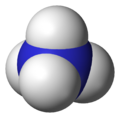Top Qs
Timeline
Chat
Perspective
Ammonium bifluoride
Chemical compound From Wikipedia, the free encyclopedia
Remove ads
Ammonium bifluoride is an inorganic compound with the formula [NH4][HF2] or [NH4]F·HF. In solid form, it is a white, crystalline salt. It is typically produced from ammonia and hydrogen fluoride.
Ammonium bifluoride is toxic and corrosive. In industry, it etches glass and has been considered as a chemical intermediate for hydrofluoric acid production.
Remove ads
Structure
Ammonium bifluoride, as its name indicates, contains an ammonium cation ([NH4]+), and a bifluoride (or hydrogen difluoride) anion ([HF2]−). The triatomic bifluoride anion features a strong three-center four-electron bond (specifically, a symmetrical hydrogen bond) with a bond energy greater than 155 kJ/mol,[2] and an H-F length of 114 pm.[3]
In solid form ([NH4][HF2]), ammonium biflouride is similar to other fluoride salts.[4] Its crystal system is orthorhombic,[5] with each cation coordinated with four anions in a tetrahedron (and vice versa). Hydrogen atoms in the ammonium ion form hydrogen bonds with the fluorine atoms, and in the resulting structure, N-H-F are roughly colinear.[6][7] As a result of these hydrogen bonds, this crystal structure varies from those of other bifluoride salts, such as potassium bifluoride and rubidium bifluoride.[5]
Remove ads
Production and applications
Ammonium bifluoride is a component of some etchants. It attacks the silica component of glass:
Potassium bifluoride is a related, more commonly used etchant.
Ammonium bifluoride has been considered as an intermediate for the production of hydrofluoric acid from hexafluorosilicic acid. Hexafluorosilicic acid ammonolyzes to give ammonium fluoride, which thermally decomposes to the bifluoride:
- H2[SiF6] + 6 NH3 + 2 H2O → SiO2 + 6 [NH4]F
- 2 [NH4]F → NH3 + [NH4][HF2]
The resulting ammonium bifluoride is converted to sodium bifluoride, which thermally decomposes to release HF.[8]
Ammonium bifluoride is also used as an additive in tin-nickel plating processes as the fluoride ion acts as a complexing agent with the tin, allowing for greater control over the resulting composition and finish.[citation needed]
Remove ads
Stability and toxicity
Ammonium bifluoride crystals are unstable, and decompose rapidly when exposed to air.[6]
Ammonium bifluoride is toxic to consume and a skin corrosion agent. Upon exposure to skin, rinsing with water followed by a treatment of calcium gluconate is required.[1] In water, ammonium bifluoride exists in chemical equilibrium with hydrofluoric acid and heating releases hydrogen fluoride gas.[9] Consequently, there is an equivalent toxicological risk as is present with hydrofluoric acid, and the same safety precautions apply.[10][9]
Ammonium bifluoride is used in some automotive wheel cleaning products. Ammonium bifluoride products are often considered a safer alternative to hydrofluoric acid, yet still pose clear risks to the handler.[10] Many users unaware of the danger have experienced injuries.[11] Professional Car Washing and Detailing magazine considers ammonium bifluoride, ammonium fluoride, and hydrofluoric acid all "too dangerous for any use in a car wash environment,"[12] and a 2015 report from the U.S. Centers for Disease Control and Prevention concurs.[13]
References
Wikiwand - on
Seamless Wikipedia browsing. On steroids.
Remove ads







